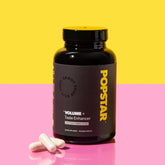Orgasm function can look different to the LGBTQ+ community. While much has been researched and written about traditional penovaginal intercourse, there’s a lack of medical knowledge regarding LGBTQ+ sexual health. Traditionally, most of the medical education has focused on HIV and STI prevention and treatments, but little effort has been put in by the medical establishment regarding the super-important topic of LGBTQ+ sexual function and orgasm.
Studies done in the United States have found that all types of men experience orgasm more frequently than women during sexual activity (Garcia 2014; Herbenick 2010; Frederick 2017). But we don’t know the specifics about how orgasm frequency breaks down in terms of gender differences and sexual orientation.
It’s crucial to note this disparity because understanding all of the factors that affect the frequency of orgasms can help provide direction for future medical research about the sexual health and wellness of LGBTQ+ populations. My goal in writing this article is to highlight some of the differences in orgasm for those engaging in non-heterosexual sex and those involved in “traditional” heterosexual sex practices and share some tips on how to get better orgasms.
Orgasm Differences by Gender and Sexual Orientation
No matter how men identify, they orgasm more frequently than women (Frederick 2017). This so called “orgasm gap” is huge! Heterosexual men report that they achieve orgasm with sexual intimacy 95% of the time. Gay men report that they reach orgasm 89% of the time and bisexual men report orgasm 88% of the time. For heterosexual women, orgasm occurs with sexual intimacy only 65% of the time. However, lesbians report orgasm 86% of the time and bisexual women report orgasm 66% of the time.
Let’s unpack those numbers, shall we? The orgasm gap between heterosexual men and women stands at a full 30%. That’s a shocking number! However, the orgasm gap between male subcategories is less. At most, there’s only a 7% difference between heterosexual, gay and bisexual men. What’s really striking is the orgasm gap between subcategories of women. Lesbian women report orgasm at rates similar to men when compared to bisexual or heterosexual women.
Given the existing medical literature, you may think that men achieve orgasm more often simply because they’re men. But the rates of lesbian women show that that’s simply not true. So why are lesbian women achieving orgasm so much more often? It’s not a huge leap to think that it might have more to do more with their sexual practices rather than their gender.
It’s important to take a quick pause here and recognize that the data above leave out transgender men, transgender women, gender non-binary and gender non-conforming people. There is a woeful lack of information that has been written on orgasmic function for these specific groups. One study found that difficulties achieving orgasm in trans women and trans men were 29% and 15% respectively (Kerckhof 2019). To truly understand the sexual function of non-cisgender groups, so much more research needs to be done.
Pro-Orgasm Sex Practices
As with all aspects of a relationship, communication is key. Some studies suggest that couples who experience orgasmic dysfunction may be lacking in sexual communication (Kelly 2004). However, we don’t really have any good data regarding the role of partner communication in the ability to achieve orgasm. Even with a lack of data, many doctors, therapists and researchers fully believe that communication helps increase the likelihood of orgasm.
A variety of sexual techniques and practices are employed to improve orgasm. For example, one study showed that women who had more frequent orgasms said that they received more oral sex and that they incorporated other practices such as trying new positions, receiving anal stimulation and engaging in sexy talk (Frederick 2017).
Research suggests that age may also play a role in orgasmic function. Younger men as well as older women report a greater frequency of orgasms. With these considerations in mind, I’ve outlined some helpful tips on how to get better orgasms, especially if you identify as LGBTQ+.
Tips to Up Your Orgasm Game
1. Anatomy 101
There are erogenous zones all over our bodies. The opportunity for sexual pleasure doesn’t just occur in our genitals. Our breasts, nipples, clitoris, labia, lips, neck, penis, vagina, cervix, uterus, anus, testicles and rectum are all erogenous zones. It’s possible for people to experience sexual pleasure and orgasm from stimulation of any of these areas. If we assume that penovaginal sex is the primary mode of orgasm, we miss out on the pleasure that these other parts of our anatomy can provide. Paying attention to all of these erogenous zones can drastically enhance your orgasmic experience.
Let’s take anal sex as an example. While it’s true that anal sex is more common among men that have sex with other men, not all homosexual men participate in anal sex. It’s also not an uncommon sexual practice among heterosexual couples. The opening and closing of the anus is controlled by internal and external sphincters that are full of nerve endings that are instrumental in facilitating pleasure or pain. While many of these nerves are located around the anal opening, the outermost portions of the rectum have them, too. If you have a prostate, you may experience greater pleasure from anal penetration which can be even more intense because this erotic gland is readily stimulated through the rectal wall.
Think about all the erogenous zones and take a minute to explore your different body parts. You may find new areas that bring you intense sexual pleasure.
2. Practice Makes Perfect
Sometimes it takes a little practice to improve your orgasms. Once you’ve become familiar with the body parts that bring you pleasure, figure out which areas feel the best and practice touching or probing them to understand how to best stimulate them. Masturbation is a great way to figure out what you like so that you can successfully communicate that information to your partner during sex. Figuring out things on your own first is like batting practice. You practice on your own so that you can knock one out of the park when it’s game time with your partner.
3. Add Some Flare
If you haven’t incorporated sexual toys or lubricants during sex, it’s time you give it a try. Toys that vibrate can increase sensitivity and can stimulate the parts of your anatomy that are not being tended to by your partner. You may find that using a vibrator on your clitoris while your partner is busy giving you oral sex can quickly level up your orgasms. Wearing a vibrating constriction ring on your penis during penetration can not only enhance your partner’s orgasm, but yours, too!
Lubricants are often overlooked, but they’re a very important tool in your orgasm toolbox. You might feel that you’re deficient in some way if you need lubricants, but that’s not true at all! Lubricants make penetration easier and more comfortable by reducing friction, and they enhance sex by increasing sensitivity. Some lubricants can create warming or cooling sensations or even delay ejaculation, which can be a big help for those who experience premature ejaculation. And flavored lubricants can make sexual activity tasty, too.
4. Intimacy is the Name of the Game
Sex in general, and orgasm specifically, is both a physical and a psychological phenomenon. Your anatomy is important, of course, but the intimacy you experience with the person you’re with can be incredibly stimulating in its own right. A study done in 2018 showed that women who intimately communicated with and received daily affection from their partner tended to have higher sexual function (McCool-Myers 2018). Kissing and cuddling are intimate acts that have been linked to sexual satisfaction for men and women alike (Heiman 2011). Focusing on your partner can be rewarding in itself, and some people even report that they had increased orgasms by sexually satisfying their partners.
There’s a long way to go when it comes to understanding the sexual and orgasmic health of the LGBTQ+ community. Specifically, I hope to see more done in terms of research around transgender, non-binary and non-conforming communities. Orgasms are one of the greatest pleasures in life, and if you are part of the diverse and beautiful LGBTQ+ community, I hope you found this article to be helpful.
References
Frederick DA, John HKS, Garcia JR, Lloyd EA. Differences in Orgasm Frequency Among Gay, Lesbian, Bisexual, and Heterosexual Men and Women in a U.S. National Sample. Arch Sex Behav. 2018 Jan;47(1):273-288. doi: 10.1007/s10508-017-0939-z. Epub 2017 Feb 17. PMID: 28213723.
Garcia JR, Lloyd EA, Wallen K, Fisher HE. Variation in orgasm occurrence by sexual orientation in a sample of U.S. singles. J Sex Med. 2014 Nov;11(11):2645-52. doi: 10.1111/jsm.12669. Epub 2014 Aug 18. PMID: 25131299; PMCID: PMC6035747.
Heiman JR, Long JS, Smith SN, Fisher WA, Sand MS, Rosen RC. Sexual satisfaction and relationship happiness in midlife and older couples in five countries. Arch Sex Behav. 2011 Aug;40(4):741-53. doi: 10.1007/s10508-010-9703-3. Epub 2011 Jan 26. PMID: 21267644.
Herbenick D, Reece M, Schick V, Sanders SA, Dodge B, Fortenberry JD. An event-level analysis of the sexual characteristics and composition among adults ages 18 to 59: results from a national probability sample in the United States. J Sex Med. 2010 Oct;7 Suppl 5:346-61. doi: 10.1111/j.1743-6109.2010.02020.x. PMID: 21029390.
Kelly MP, Strassberg DS, Turner CM. Communication and associated relationship issues in female anorgasmia. J Sex Marital Ther. 2004 Jul-Sep;30(4):263-76. doi: 10.1080/00926230490422403. PMID: 15205064.
Kerckhof ME, Kreukels BPC, Nieder TO, Becker-Hébly I, van de Grift TC, Staphorsius AS, Köhler A, Heylens G, Elaut E. Prevalence of Sexual Dysfunctions in Transgender Persons: Results from the ENIGI Follow-Up Study. J Sex Med. 2019 Dec;16(12):2018-2029. doi: 10.1016/j.jsxm.2019.09.003. Epub 2019 Oct 24. Erratum in: J Sex Med. 2020 Apr;17(4):830. PMID: 31668732.
McCool-Myers, M., Theurich, M., Zuelke, A. et al. Predictors of female sexual dysfunction: a systematic review and qualitative analysis through gender inequality paradigms. BMC Women’s Health 18, 108 (2018).
































